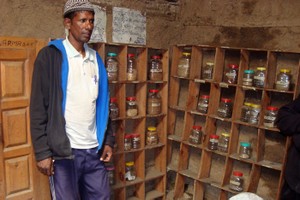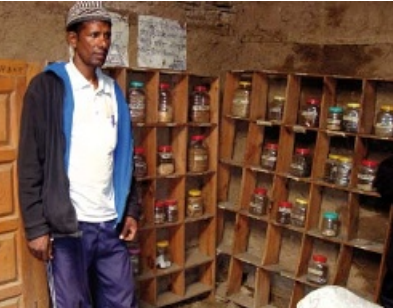With less than one percent of the world’s area, Nepal is home to a disproportionately large number of plant species. Yet large numbers of the population are food insecure, and hunger and malnutrition are prevalent. Statistics show that the situation has worsened during the past two decades. The worst-affected segments of the population are the tribal and nomadic communities, whose local agriculture and natural resource management systems are jeopardised by public and private programmes built around a high-external-input agriculture. Isn’t it time to try a different approach?

For many centuries, Nepalese farmers have been growing thousands of plant species and using them as part their diet, including – but certainly not limiting themselves to – many varieties of millets, barley and buckwheat. The country is currently facing considerable socio-economic and political difficulties, all of which are having a serious impact on agriculture and on the country’s food systems. Low yields and poor harvests are only adding to the difficulties in the rural areas and in the country in general.
Policies put into practice
Given the prevalence of hunger and malnutrition, it is not surprising that the National Agriculture Policy stresses the importance of ensuring food security. These policies, however, don’t always seem to be headed in the right direction.
They expect an open market economy to help all consumers have access to cheaper products, even if these come from abroad. And the policies that focus on what the country needs to produce in order to feed its population concentrate on just six crops (rice, maize, wheat, barley, finger millets and buckwheat), disregarding all other crops, even though these contribute to at least 40% of the average diet. National regulations are also supportive of “the use of hybrids and GMOs for increasing productivity”.
These general guidelines shape many of the public efforts to tackle food insecurity. One of these, for example, has been seen in the Karnali region, in Nepal’s far west, an area that has seen severe food shortages for more than 20 years. Instead of developing programmes designed to raise yields or diversify outputs, the efforts of the government, and also those of the non-governdevelment sector, have focused on providing free (or very cheap) coarse rice brought from other regions or from abroad to farmers and the rural population.
Another example is the Maize Mission Programme. This programme tried to help small-scale farmers get higher yields by distributing seeds of different hybrid maize varieties. The aim was to sow 34,000 hectares of hybrid maize in the central and eastern parts of the country, but the modern maize varieties responded poorly to the environment where they were expected to grow. Thousands of farmers suffered the consequences of the total failure of these crops and the seed companies blamed the failure on technical problems and climate change.
Local crops
Crosp for the futureThe use of neglected and underutilised crops (NUS) has also been promoted at the international level by two organisations: the International Centre for Underutilised Crops (ICUC), established in 1992 and operating out of Sri Lanka since 2005, and the Global Facilitation Unit for Underutilized Species (GFU), set up in 2002 in Rome. ICUC and GFU merged in 2009 to become Crops for the Future (CFF), now based in Serdang, Malaysia. Its mission is to contribute to agricultural diversification through greater use of NUS for poverty alleviation and dietary diversity.
CFF seeks to achieve this mission by:
- acting as a knowledge broker and information portal for NUS;
- enhancing awareness of the value and functions of NUS;
- advocating policies that do not discriminate against the use of NUS, and
- assisting countries to build capacity in NUS education.
In recognition of the importance of CFF’s mandate, the government of Malaysia has recently made available considerable resources to launch the CFF Research Center. With Nottingham University in Malaysia and the Malaysian Government as its guarantors, CFFRC will provide a sizeable research and training facility exclusively dedicated to NUS.
In spite of the difficulties they regularly face, Nepalese farmers contribute most of the country’s staple foods; their contribution goes far beyond the six staple cereals. In addition to growing millets and local landraces of rice, wheat and maize, it is not uncommon to find fields with Amaranthus, or to find farmers growing or collecting Urtica dioica (“shishnu” or stinging nettle), Diplazium ferns, Bauhinia purpurea or Dioscreta alata (purple yam). These species are appreciated for their medicinal and nutritional qualities: Amaranthus and Urtica have a high iron content; foxtail millets are rich in carbohydrates and Bauhinia in minerals.
These local crops help families meet their needs in terms of staples, vegetables and pickles, and on many occasions also contribute in terms of income. This was recently shown in a research study carried out in Chitwan, in central Nepal, with the Cherpang tribal community. This identified 46 species that were used locally, of which 25 were vegetables or medicines.
Villagers described how these crops complement each other in terms of taste, and how some are prized because they fill the gap in the “hungry months” when no other foodstuffs are available. Farmers in Chitwan also described the agronomic advantages of these crops: they are well adapted to the local agro-ecological conditions and tolerate pests and diseases.
Moreover, these local crops are known to be “low-input”, mostly requiring no irrigation, no fertilizers, and allowing farmers make productive use of marginal lands.
Yet, although their advantages are many, most of these local crops are seen as “poor people’s food” – both by the authorities and by consumers themselves (finger millets, for example, are known as “kuanna” in Nepal, literally meaning “bad cereal”). There is little or no research, and little investment for technological development. Farmers lack extension services or information on how to get higher yields, and they also find it difficult to find seeds or propagation material. Not surprisingly, most local crops are easily described as “neglected” or “underutilised” species.
Securing the seeds
Fortunately, there are many organisations that recognise the potential of these neglected crops. One of these is SEDA, the Sustainable and Equitable Development Academy. Building on the regular seed exchange initiatives that are widespread in rural areas, SEDA has been encouraging farmers to get together, with each of them bringing seeds of different species and then taking other seeds from their neighbours. These ideas have been developed further into a “seed bank” initiative, which SEDA started with the support of ActionAid Nepal. In short, the idea of a seed bank consists of
- developing a “seed map”, highlighting the availability, most important features and productivity of different species and their suitability to local conditions;
- the selection of seeds and the implementation of a breeding programme at a local level (with farmers, on their farms);
- the establishment of the seed banks (or actually the “seed storehouses”), where seeds of locally promising varieties are stored in sacks, mud pots or using other indigenous techniques and structures; and
- the distribution of the seeds to farmers during the planting season, with farmers returning the same amount of seeds after the harvest.
Perhaps the most significant criteria for selection is that only the seeds of local crops are stored, not those of the hybrids and improved varieties developed by national research institutions.
These ideas have been put into practice since 2007 in the Jumla district, starting in the Village Development Committees (VDCs) of Lamra and Talium, where the local banks now store seeds of more than 60 local varieties, including cereals and legumes. This initiative was extended later to Kartikswami, Garjyangkot and Badki, other VDCs in the same district, and other organisations are now supporting the programme. The Rural Development Group Programme (RDGP) and the Radha Krishna Jana Sewa Center are both working in order to “conserve through use” promising local crop land races and varieties. These efforts are helping farmers have the necessary seeds “close to hand and in time”, and thus to be able to grow the local crops that interest them.
A step in the right direction
Seed banks contribute enormously to food security by ensuring the timely availability of seeds of useful crops. They encourage the cultivation and consumption of these crops, benefiting producers and consumers. Both farmers and the organisations behind the seed banks see them as a step in the right direction and see the need to develop these initiatives further to ensure the cultivation and consumption of neglected local crops. Nepal’s Seed Laws, for example, only provide patent rights to breeders, and there are no provisions for farmers’ varieties. Local seed banks have no legal recognition. ActionAid is therefore also engaged in advocacy programmes, lobbying in favour of these organisations and of the use of local crops. Farmerfriendly policies can help ensure that seed banks remain operative and, through them, that the local crops are no longer neglected.
Text: Bed Prasad Khatiwada, Bhim Chaulagain, Surendra Osti, Dinesh Gurung, Man Bahadur Dangi and Krishna Thapa
Bed Prasad Khatiwada is the Theme Leader for the Right to Food and Land, for ActionAid Nepal.
Dinesh Gurung works as Resource Center Coordinator, Western Resource Center, also with ActionAid Nepal.
Surendra Osti and Bhim Chaulagain are both researchers within SECARD NEPAL.
Man Bahadur Dangi is the Program Coordinator at RKJS.
Krishna Thapa is the Program Coordinator at SEDA Jumla, Nepal.

